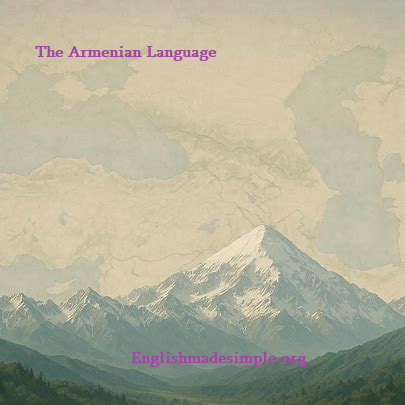The Armenian language
Introduction:
The Armenian language, one of the oldest Indo-European languages, holds a rich linguistic and cultural heritage that spans millennia. Its origins, evolution, and contributions to literature and society make it a fascinating subject of study. This short article delves into the history, development, dialects, and current status of the Armenian language.
Origins and History:
Armenia, located in the Middle East, is the homeland of the Armenian people. It is believed that the Armenian language originated in the Armenian Highlands over 4,000 years ago. The roots of the Armenian language trace back to the Indo-European language family, and more specifically, to the Armenian branch of the Indo-European tree. Scholars generally agree that the Armenian language emerged around the 6th century BCE, making it one of the oldest living languages with an extensive written history. The earliest evidence of the Armenian language comes from inscriptions found in the kingdom of Urartu, reflecting the influence of the Urartian civilization on its early development.
Development and Evolution:
The Armenian language has undergone significant linguistic changes throughout its history. The Classical Armenian period (5th to 11th centuries CE) is marked by the creation of the Armenian alphabet in the 5th century by the monk Mesrop Mashtots. This pivotal development allowed for the translation and preservation of religious and literary works, fostering a unique Armenian literary tradition.
During the Middle Ages, Armenian experienced influences from neighbouring languages due to geopolitical shifts and contact with different cultures. The language underwent phonological and grammatical changes, leading to the emergence of the Eastern and Western dialectal groups.
Similarities and Differences with Related Languages:
Armenian belongs to the Indo-European language family and shares certain linguistic features with other members, such as Iranian and Greek languages. However, its unique alphabet and distinct grammar set it apart. Although it has absorbed loanwords from various languages over the centuries, Armenian maintains its own identity.
Dialects:
The Armenian language has two main dialectal groups: Eastern Armenian and Western Armenian. Eastern Armenian is the official language of the Republic of Armenia, while Western Armenian is primarily spoken by the Armenian diaspora. Both dialects have sub-dialects influenced by regional variations, reflecting the historical and geographical diversity of Armenian communities.
Number of Speakers and Geographic Distribution:
Armenian is spoken by approximately 6-7 million people worldwide. The majority of speakers reside in the Republic of Armenia and the diaspora communities in countries such as Russia, the United States, France, and Lebanon. The dispersion of the Armenian population, particularly after the Armenian Genocide of 1915, has contributed to the preservation of Western Armenian among diaspora communities.
Literary Works:
The Armenian literary tradition dates back to the early Christian period, with notable works such as the translation of the Bible into Armenian and the writings of prominent figures like Movses Khorenatsi and Yeghishe. Over the centuries, Armenian literature has flourished with works by poets, novelists, and playwrights, contributing to the cultural wealth of the Armenian people.
Current Situation:
In the modern era, the Armenian language faces challenges and opportunities. The Republic of Armenia has actively promoted the use of Armenian in education, media, and official documents. However, the diaspora communities, particularly those speaking Western Armenian, grapple with the threat of language shift and preservation.
Grammar:
Conclusion
In conclusion, the Armenian language stands as a testament to the endurance of cultural and linguistic identity. Its historical development, diverse dialects, literary contributions, and current challenges collectively shape the dynamic landscape of the Armenian linguistic experience. It is a distinct Indo-European language and still continues and flourishes to this day whereas other Indo-European languages have fallen by the wayside.
Leave a comment!
Here is a video related to the Armenian language.
- Afrikaans, click on this link.
- Albanian, click on this link.
- Amharic, click on this link.
- Arabic, click on this link
- Armenian, click on this link.
- Assamese, click on this link.
- Aymara, click on this link.
- Azeri,click on this link.
- Bambara, click on this link.
- Basque, click on this link.
- Belarusian, click on this link.
- Bengali, click on this link.
- Bosnian, click on this link.
- Bulgarian, click on this link.
- Catalan, click on this link.
- Cebuano, click on this link.
- Chewa, click on this link.
- Chinese, click on this link.
- Corsican, click on this link.
- Croatian, click on this link.
- Czech, click on this link.
- Danish, click on this link.
- Dhivehi, click on this link.
- Dogri, click on this link.
- Dutch, click on this link.
- Estonian, click on this link.
- Ewe, click on this link.
- Faroese, click on this link.
- Fijian, click on this link.
- Filipino, click on this link.
- Finnish, click on this link.
- Fon, click on this link.
- French, click on this link.
- Frisian, click on this link.
- Fulani, click on this link.
- Ga, click on this link.
- Galician, click on this link.
- Georgian, click on this link.
- German, click on this link.
- Greek, click on this link.
- Guarani, click on this link.
- Hausa, click on this link.
- Hawaiian, click on this link.
- Hindi, click on this link.
- Hunsrick, click on this link.
- Hungarian, click on this link.
- Icelandic, click on this link.
- Igbo, click on this link.
- Ilocano, click on this link.
- Indonesian, click on this link.
- Inuktut, click on this link.
- Irish, click on this link.
- Portuguese, click on this link.
- Spanish, click on this link.
- Turkish, click on this link.
Leave a comment on what you think.

